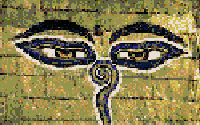
BREATHING
What seems like a ludicrously common subject is in fact one of the
primary objects of ill-health in the west. Yes, we are breathing
creatures [prani], but only in the sense of autonomous breath. When
we run, our body dictates a higher rate of respiration. When we
sleep, the cycle reduces. What most people do not practice is
controlled breathing. Autonomous respiration is typically shallow,
air is drawn with the least amount of effort the diaphragm requires.
This uses only the top third of the lungs. The yogic breath,
employed during meditation, and ideally employed as often
impossibly, involves working the diaghragm to draw air in & out of
the entire lung cavity, from the lowest (toward the stomach) to the
middle to the top. This is not an eastern secret. Performers,
especially actors and operatic singers are well aware of the
exercise and usage of the complete required to give the voice
necessary strength. If you have ever stood near an opera singer
wgile they practice, you can't help noticing the power a voice can
attain when the breath is well used.
The Tantrics use complete breathing to capture the vital air
[pranavayu]. Prana is a energy [tejas] containing breath, that
provided a charge of life above and beyond mere respiration.
Pranamayu is the regulation of this vital prana through the use of
breathing.
The Vayu, the 10 airs or inner vital forces are said to be visible
under certain conditions. The first five are even identified by
their colors:
1. The Sapphire Prana.
2. Apana, the color of an evening cloud.
3. The silver Vyana, effecting division and diffusion.
4. Vdana, the color of fire.
5. The milky Samana, which kindles bodily fires.
The ascending Vayu is called Upana, the descending Apana.
Prana is an inspiration, which when expired extends a distance of 8
to 12 inches form the mouth.
The Tantrics take breath quite seriously, and regard every state of
the body, from tempurature to comfort to energy as messages which
instruct the adherent to the state of their experiences. In
advanced stages of breathing, combined with meditation, the mood of
erotic excitement [suprahrs'ta] may be experienced unexpectedly, a
sign of successful practice.